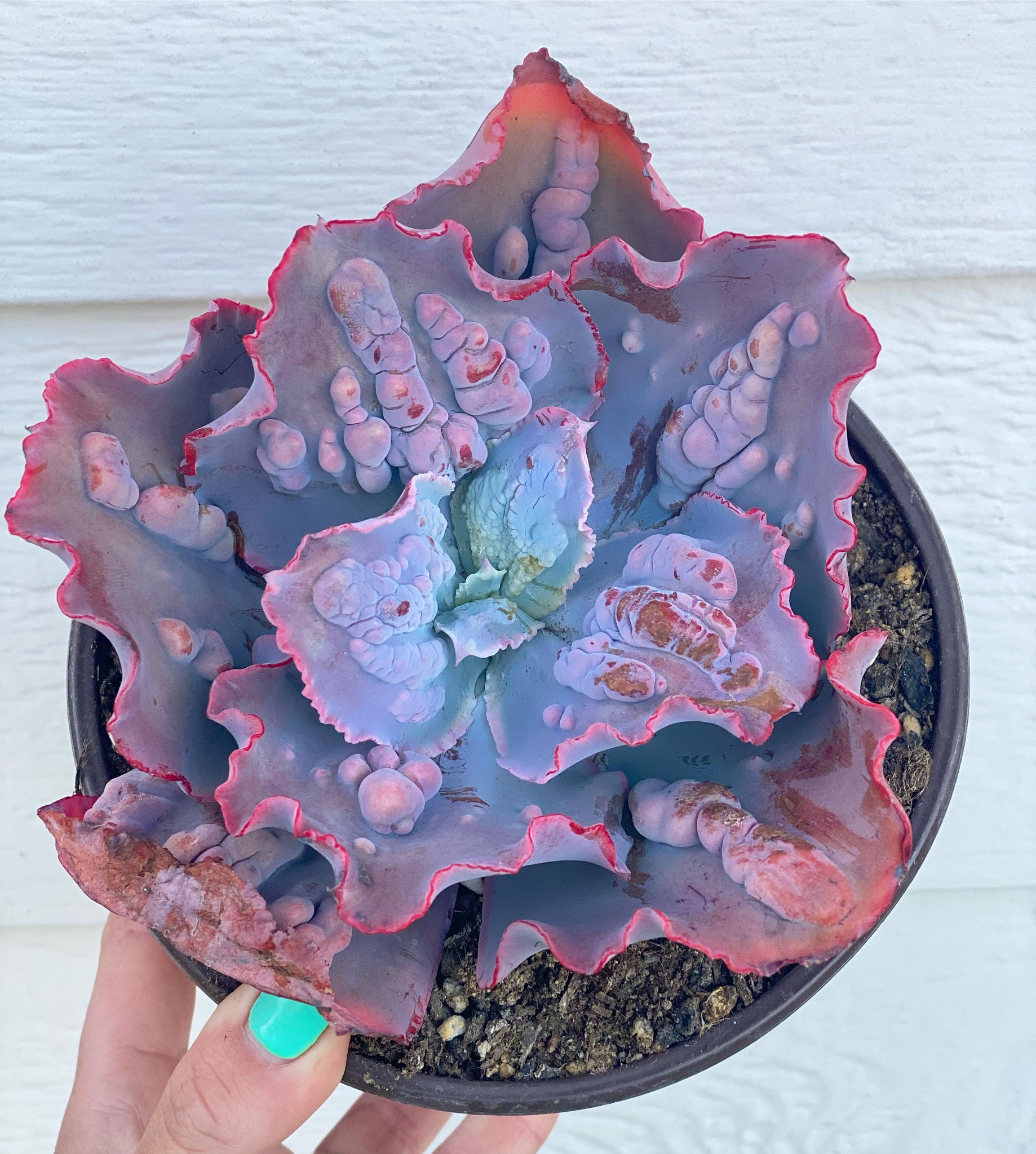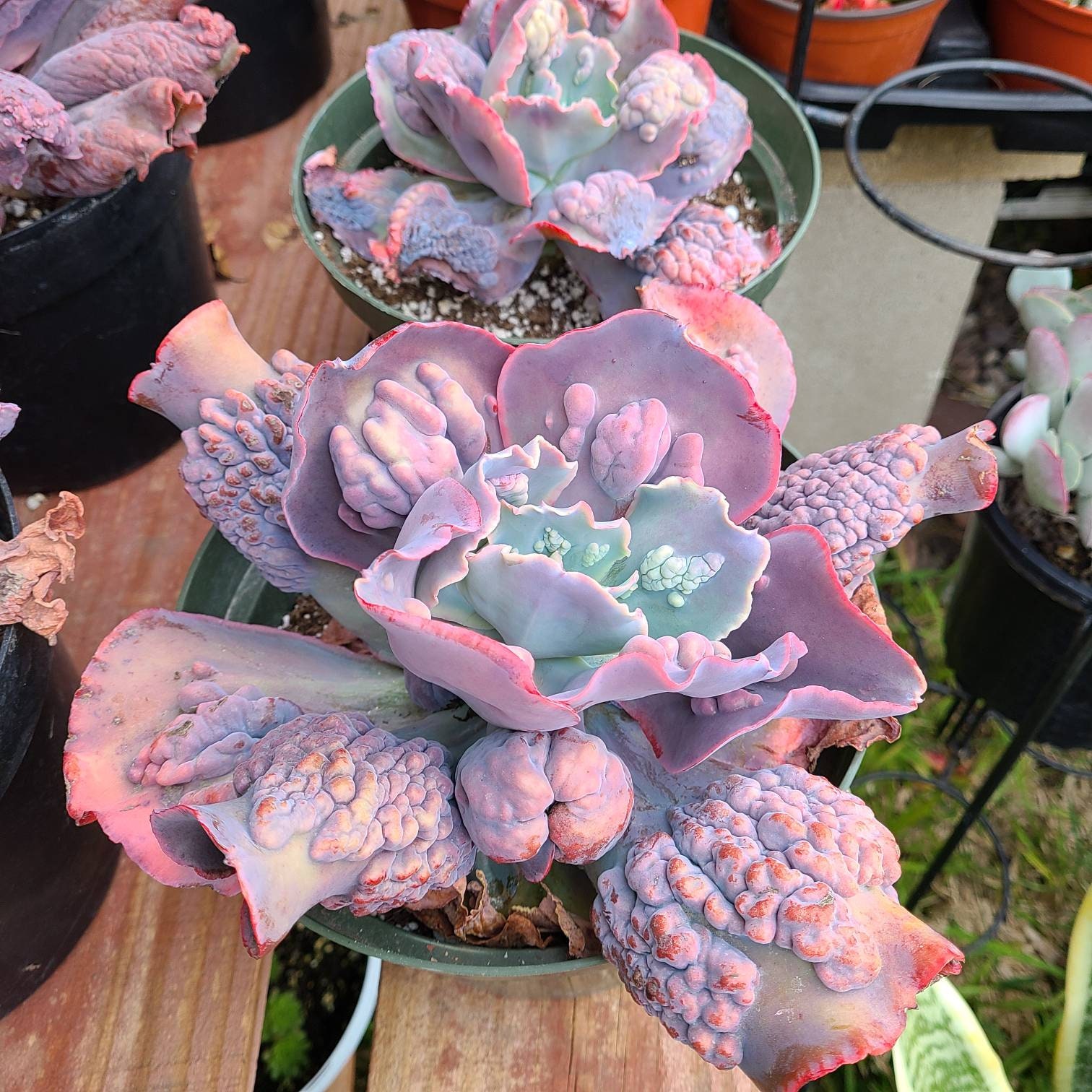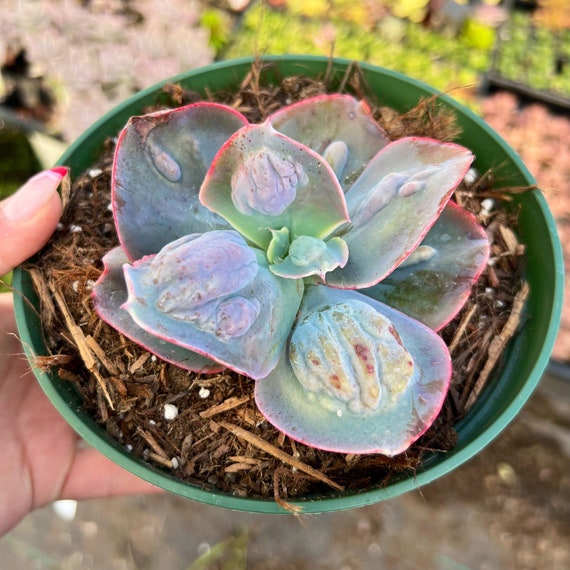This peculiar-looking succulent appears to have some damaged leaves, yet this is actually its typical growth pattern. ‘Etna’ has large, waxy, purple-blue leaves. During the summer, they fold inwards to form a spear-like shape, while in the winter they spread out in order to absorb more sunlight.
Table of Contents
Care and Propagation Information
Adding ‘Etna’ to rock gardens is a great idea. This Echeveria gibbiflora hybrid forms a single rosette that can grow quite wide, so it shouldn’t be placed in a group with low-growing succulents. During the Summer months, it produces eye-catching orange and yellow flowers.
Watering
It’s best to water Echeveria ‘Etna’ using the “soak and dry” method, which involves letting the soil dry out completely before giving it another soak. This is the most recommended way of watering succulents.
Where to Plant
If you are located in an area with temperatures lower than 30° F (-1.1° C), it is best to keep ‘Etna’ in a pot that can be brought indoors during cold seasons. This succulent thrives in an environment that receives full to partial sunlight.
Put your plants in an environment that receives at least 6 hours of direct sunlight each day. If planting indoors, position the pots close to a south-facing window to ensure they receive sufficient amounts of natural light.
How to Propagate Echeveria ‘Etna’
Echeveria ‘Etna’ can be reproduced through the use of cuttings and offsets.
Cuttings
To propagate ‘Etna’, use a clean and sharp knife or scissors. Cut a stem off the mother plant and let the cut end heal for a few days. Place the stem in a soil that drains well and water it only when the soil is completely dry.
A fresh rosette will emerge from the original stem.
Offsets
Echeveria ‘Etna’ will grow small offshoots at the bottom of the plant. Carefully remove these and let them sit in the air for one or two days before replanting them.
Additional information
Care and Propagation Information
General Care for Echeveria ‘Etna’
Adding ‘Etna’ to rock gardens is a great idea. This Echeveria gibbiflora hybrid forms a single rosette that can grow quite wide, so it shouldn’t be placed in a group with low-growing succulents. During the Summer months, it produces eye-catching orange and yellow flowers.
Watering
It’s best to water Echeveria ‘Etna’ using the “soak and dry” method, which involves letting the soil dry out completely before giving it another soak. This is the most recommended way of watering succulents.
Where to Plant
If you are located in an area with temperatures lower than 30° F (-1.1° C), it is best to keep ‘Etna’ in a pot that can be brought indoors during cold seasons. This succulent thrives in an environment that receives full to partial sunlight.
Put your plants in an environment that receives at least 6 hours of direct sunlight each day. If planting indoors, position the pots close to a south-facing window to ensure they receive sufficient amounts of natural light.
How to Propagate Echeveria ‘Etna’
Echeveria ‘Etna’ can be reproduced through the use of cuttings and offsets.
Cuttings
To propagate ‘Etna’, use a clean and sharp knife or scissors. Cut a stem off the mother plant and let the cut end heal for a few days. Place the stem in a soil that drains well and water it only when the soil is completely dry.
A fresh rosette will emerge from the original stem.
Offsets
Echeveria ‘Etna’ will grow small offshoots at the bottom of the plant. Carefully remove these and let them sit in the air for one or two days before replanting them.
Additional information
The term ‘Etna’ originates from Mount Etna, a volcanic mountain located in Italy which is still active today.
FAQ
Where does the name Echeveria Etna come from?
The moniker was derived from Mount Etna, an active volcano located in Sicily, Italy.
What are the bumps on echeveria leaves?
Echeveria raindrops is a beloved, hard-to-find succulent, prized for its caruncles, or small bumps or warts that store water on its leaves. Unfortunately, when new owners bring the plant home, their bumps can often disappear due to environmental changes.
What are the white balls on my succulent?
If you take the time to check on your succulents regularly, it is easy to detect mealybugs. You can identify them by looking for small white clumps of fluff on the leaves of your plant – a sure sign of an infestation.
What are the bumps on Echeveria Etna?
The leaves of each plant have their own distinct characteristics, with carunculations dotting the surface of the older foliage and changing colors throughout the year. These bumps are typically a deep purple, making the plant stand out from its counterparts and giving it a unique personality.
Does Echeveria need direct sunlight?
It is essential that you put your echeveria in a window where it is exposed to no less than six hours of direct sunlight daily. If you don’t give it long periods of direct light, it will start to become leggy and not retain its attractive, dense shape.



